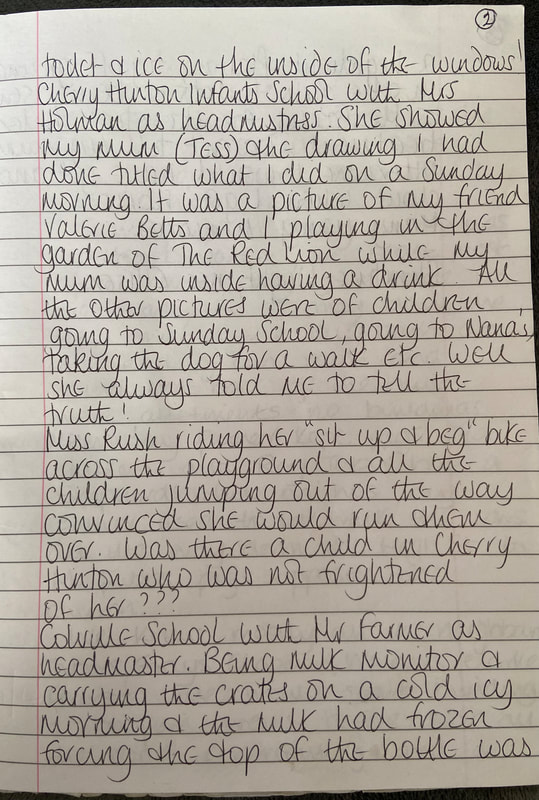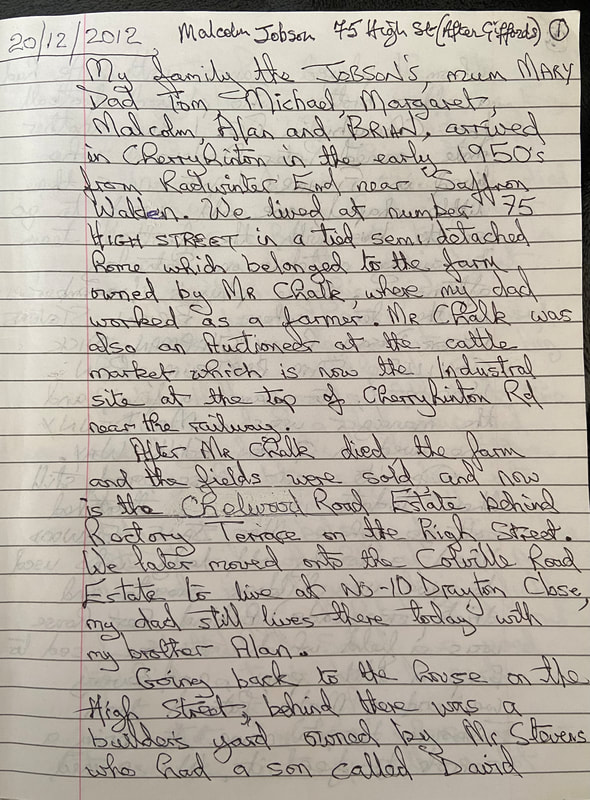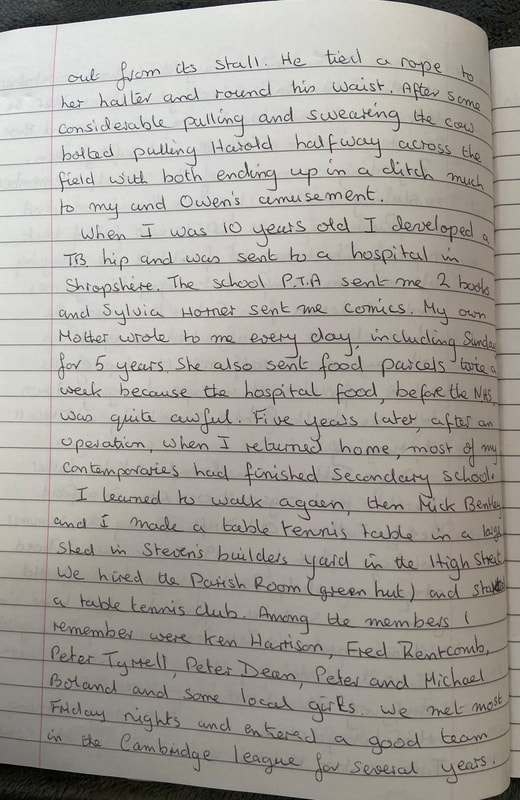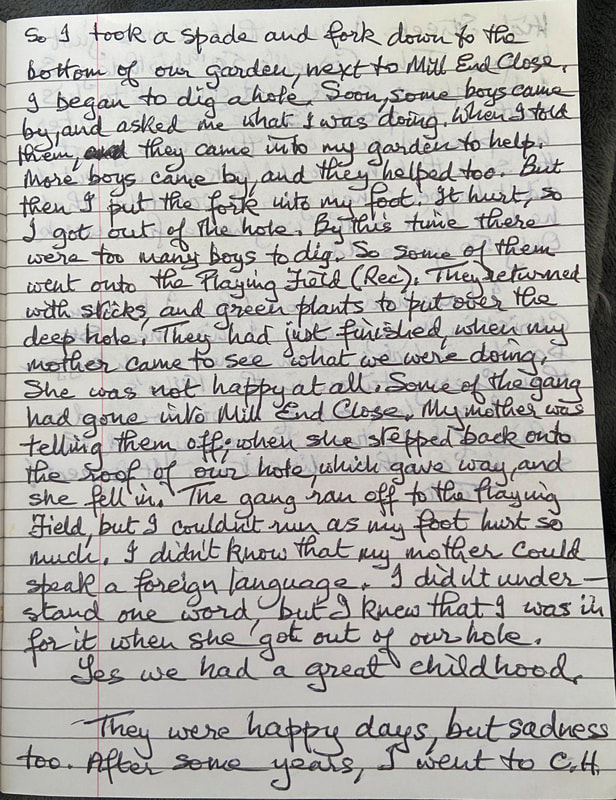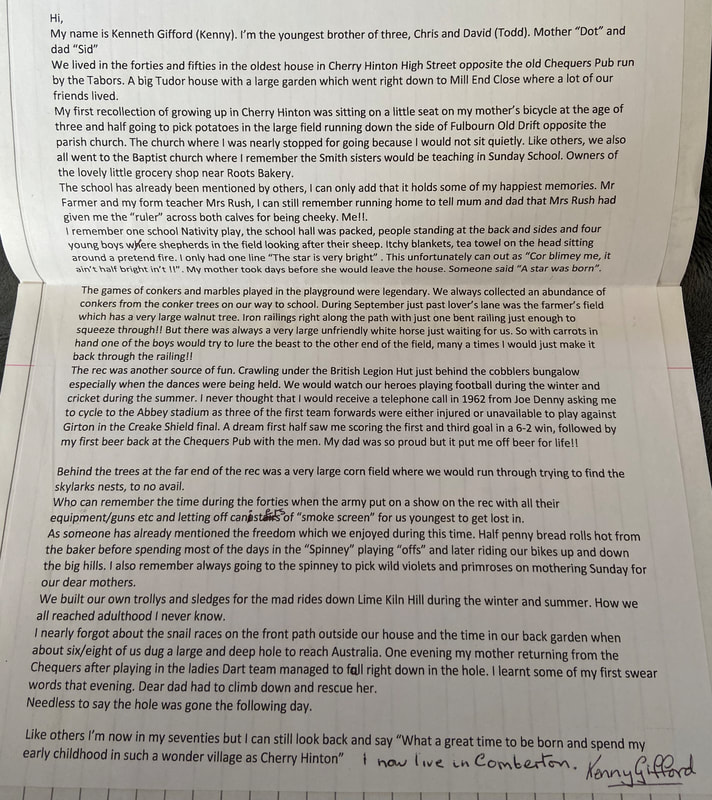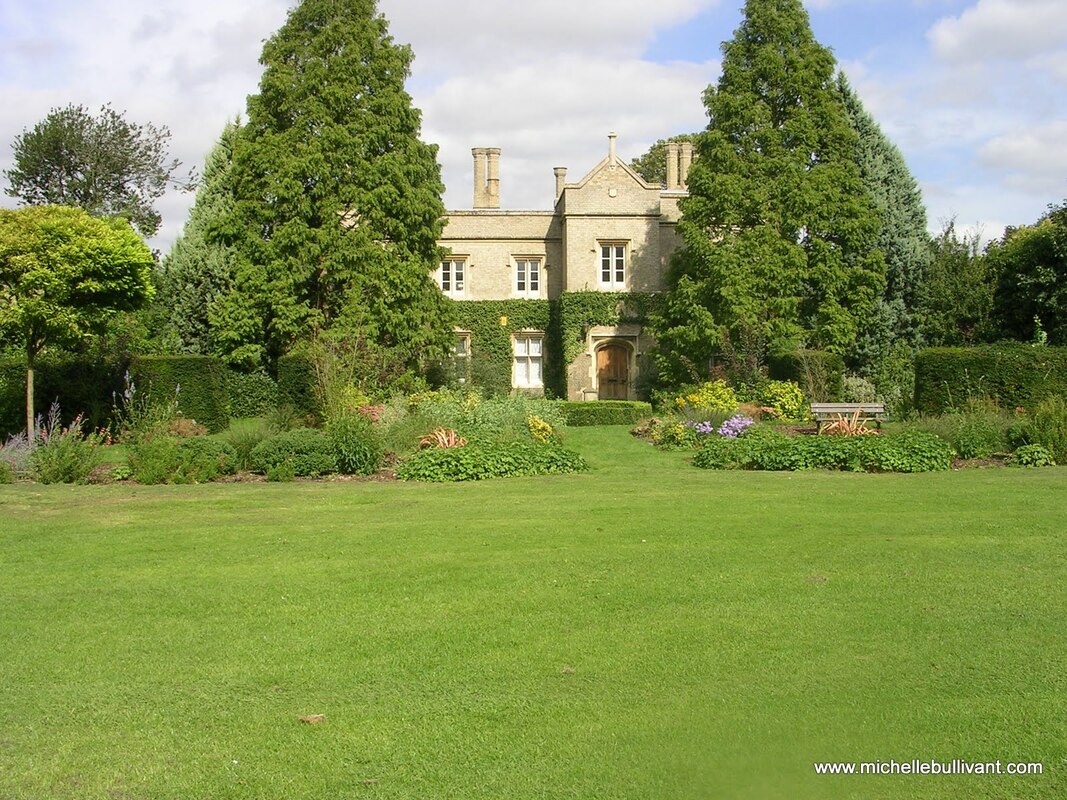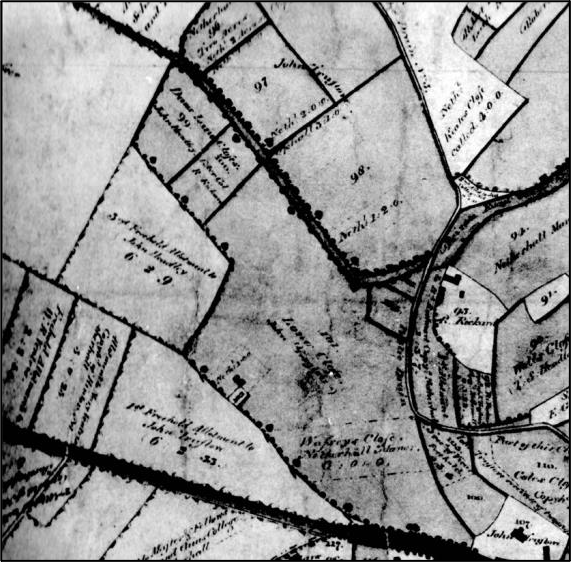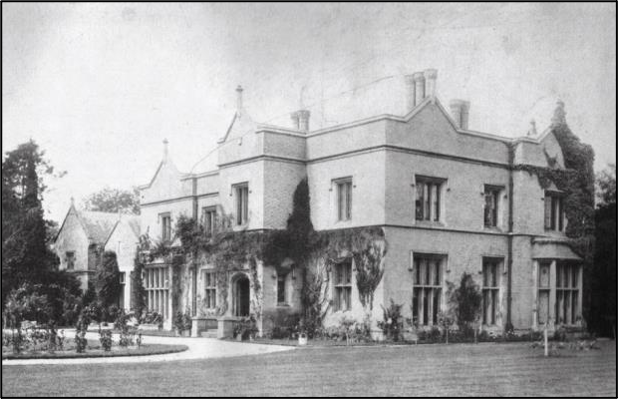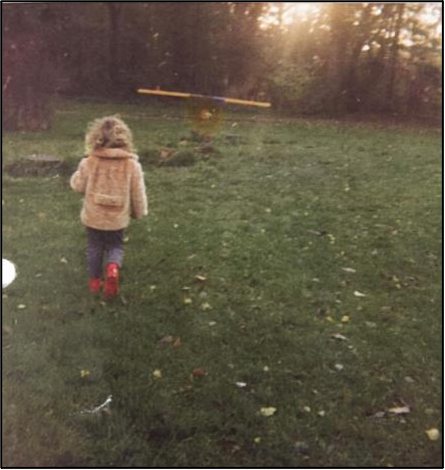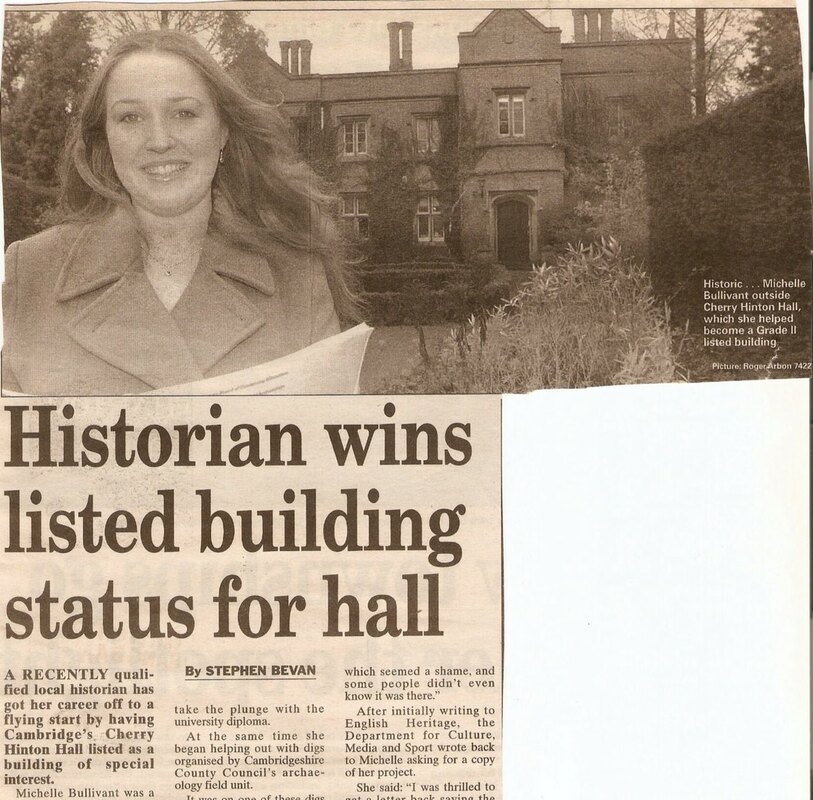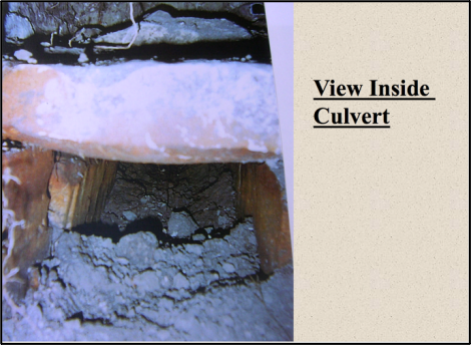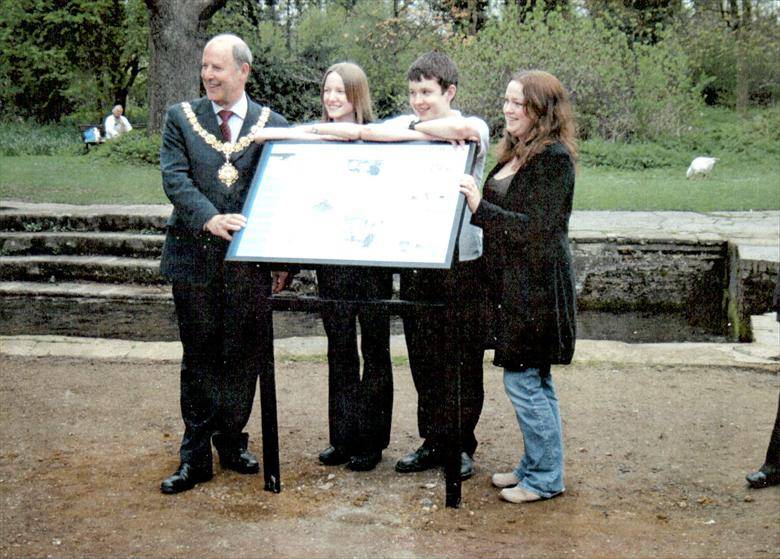|
Here you will find the complete contents of Cherry Hinton Memories Book Three - if you haven't done so already, I would encourage you to take a brief look at the introduction page about these books first - which you can do by clicking the link here: Cherry Hinton Memory Books - Introduction
There are three books altogether and one separately written story - you can find the links to the other books and story by visiting the Cherry Hinton Memory Books Introduction page, mentioned above, or by searching the index (Categories) on the righthand side of this page or by using the search box on the right.
BOOK THREE
Book Three “The Golden Years - Cherry Hinton, 1930's-1960's"
Contains memories from: Unknown Christine Wright Mavee Williams Malcolm Jobson Bett Dawson Stuart Nunn Neville Cullup Basil Simpkins Tony Tabor David Gifford Kenneth Gifford
Below you will find the full transcription of book three, copied as it is, with pictures of the handwritten stories to compare (and send me any corrections!). You can choose to read through it here or, for more detail, you can click on one of the names above to see their story individually and any extra pictures that I have added to illustrate their story.
Book 3 The Golden Years Cherry Hinton 1930's-1960's.
Unknown: Cherry Hinton Memories
I was born in the middle of the night in February 1944, in a council house up Fulbourn Road beside the Spinney and at the other end was a big Dutch barn, both the Spinney and the Dutch barn were ideal for children to play in. The council houses at Fulbourn Road were the latest in Cherry Hinton, completed in 1939. They had flushing toilets, a luxury that not everyone enjoyed in England during the 1940’s. I recall in my pre-school days the High Street was not made up and not kerbed all the way from the Robin Hood corner to the school – which was opposite Ling’s sweet shop. We could drink the water from the natural spring opposite the Robin Hood where wild Honeysuckle grew and Moorhens nested on the island. There was a green triangle that made the slip road from Queen Edith's way to Cherry Hinton Road and Mr Scott, who lived in the first house by the Spinney in Queen Ediths Way used to hold Sunday service for the young men of the parish. There were two thatched cottages in the corner of the Spinney opposite the Robin Hood where the late Bricky Mason used to live in one. Turkeys often wandered along the High Street from Stevens Builders Yard where they were being fattened up for Christmas (meat was on ration). In the late 1940’s for pre-school children Cherry Hinton was idyllic with the war over. We had the Spinney, the Recreation Ground, Cherry Hinton Hall, the chalk pits and lime pits, with only the chalk pits still being worked of these – we could roam free all over the village. Fulbourn Road in the late forties and early fifties was home to lots of children. The games we played too numerous to remember all. The council house side was on a sub-road with only one entrance for cars, you could draw anything on the road and play. There were several variations of hop-scotch and with the Spinney and chalk pits nearby there was no shortage of chalk. I recall the game with the most competitive edge, passion, and arguments, that lasted days or until the next time all the children were available for a re-match was rounders – “boys against girls a catch was the whole side out”. On the Recreation Ground then half the size it is now, as Bullard’s Brewery owned the Chequers and allotments behind it, there was Sid Hancock’s bungalow – the village cobbler. The old British Legion “Hut” as the locals called it was a long, mainly wooden structure built on raised concrete stilts, therefore small children could easily move underneath it. The Rec in those days had lots of bushes around it and small copses of trees more natural and evolved than the well organised and designed as today – but much more fun for children. On V.E. day in May 1945 Fulbourn Road children had a celebration party under the Dutch barn. In the late 40’s and early 50’s on a Saturday morning and early arrival was Mr Hardwick who came down the Fulbourn Road with a horse and cart, it was a mobile shop. A thatched cottage caught fire on Saturday morning in the High Street 1955 and the Esso Garage and Petrol Station were built there.
Christine Wright nee Ellison Cherry Hinton Memories 12 Nov 2012
Cherry Hinton in the 50’s & 60’s was very special. I know everyone will say that about their village but it is true. Bert Quinney’s shop – he could serve 10 people at once as he knew who came in for cigarettes & what brand, he knew who paid cash and who had “tick”. I am sure he was the shopkeeper who “Open All Hours” character “Arkwright” was based on. Pledges newsagent in Coldhams Lane used to sell comics which were out of date much cheaper. I used to love going there to get “Bunty”. Greenwoods sweet shop near the railway was so small. In the 70’s Mrs Greenwood used to do chiropody. Our Sunday “paper boy” was Jim Chapman – bringing us the News of the World. We lived in the prefabs in Teversham Drift which were lovely & warm until 1964 when we had to move to Fulbourn Road as they were going to be demolished. The house in Fulbourn Road was a shock as there was an outside toilet & ice on the inside of the windows! Cherry Hinton Infants School with Mrs Holman as Headmistress. She showed my mum (Tess) the drawing I had done titled ‘what I did on a Sunday morning’. It was a picture of my friend Valerie Betts and I playing in the garden of the Red Lion while my mum was inside having a drink. All the other pictures were of children going to Sunday School, going to nana’s, taking the dog for a walk etc. Well, she always told me to tell the truth! Miss Rush riding her ‘sit up & beg’ bike across the playground & all the children jumping out of the way convinced she would run them over. Was there a child in Cherry Hinton who was not frightened of her??? Colville School with Mr Farmer as Headmaster. Being milk monitor & carrying the crates on a cold icy morning & the milk had frozen forcing the top of the bottle was a highlight. Playing tig off ground in the girls toilets & being sent to Mr Farmer for the steel ruler treatment. Daren’t tell my mum otherwise I would have got another clout when I got home. Many, many memories. Christine Wright nee Ellison
Maree Williams nee Stevens Cherry Hinton Memories Nov 2012
My sister and I were born in the front room of Fulbourn Road in 1944, and I lived there until I got married. Growing up in Cherry Hinton was childhood heaven, we spent most of our time playing outside in the road, the Spinney, down the Rec and in the big barn at the end of our road and round the back of the houses there were allotments, no buildings then. My father kept pigs and chickens and Roy Tabor had a shepherd’s hut on his. My father used to walk the sows all the way down the High Street to Mr Fabbs pigs opposite the church. We knew mostly all the neighbours, Tabors, Grays, Chapman, Walders, Clarke, Pearson. We would start building a bonfire weeks before Nov all the road contributing and on Nov 5th used to go with our potatoes. No fancy fireworks then – bangers, rockets, Catherine wheels. We would try and keep embers going for days. We used to be sent to shop in Smiths. – on the bk, and George Parish the butchers used to have a bike with a huge basket on the front, smoking and coughing his heart out, then there was Arkright himself – Bert Quinney with his brown coat on. Love Lane was another haunt there was a scrummy pear tree in the middle of the field ideal for scrumping, messing about down the island and falling in trying to get to the middle, playing in the buttercup field opposite the Spinney, doing a paper round on the new estate after collecting the papers from Jim Chapman in Coldhams Lane We used to walk round from school once a week for country dancing, a lady used to play the accordion, and many happy times spent in the Tin Hut, it looks a bit worse for wear now. We also had lots of dancing etc. in the British Legion Hall down Fishers Lane, mostly every week there were live groups, rock, roll and skittle, Mark Arnold and Jonny Collum absolutely packed, great, happy times.
Malcolm Jobson Cherry Hinton Memories – 20/12/2012 – 75 High Street (after Giffords)
My family, the Jobson’s, mum Mary, dad Tom, Michael, Margaret, Alan and Brian, arrived in Cherryhinton in the early 1950’s from Radwinter End near Saffron Walden. We lived at number 75 High Street in a tied semi-detached home which belonged to the farm owned by Mr Chalk, where my dad worked as a famer. Mr Chalk was also an auctioneer at the cattle market which is now the industrial site at the top of Cherry Hinton Road near the railway. After Mr Chalk died, the farm and the field were sold and now is the Chelwood Road estate behind Rectory Terrace on the High Street. We later moved onto the Colville Road estate to live at No. 10 Drayton Close, my dad still lives there today with my brother Alan. Going back to the house on the High Street, behind there was a builders yard owned by Mr Stevens who had a son called David whom I played games with. He had a elder brother who played football for Cherryhinton F.C. I had another mate named Peter Anderson who lived in Fishers Lane near the little chapel, we all used to go on the bus with the football team to away matches on Saturday afternoons. Some player’s I remember in the team were, Brian Stevens, Peter Dean, Billy Chapman, Mick Colville, Sam Bartrum, Ron Hagerty, to name a few, and the manager was a Mr Denny who lived in Queen Edith’s Way. Opposite our house, and still there today is a little thatched cottage where Mrs Jane Elwood lived, a lovely old lady who used to give us children sweets and drink (orangeade). Behind her house was a field which someone used to keep a little pony, and every weekend a male patient from Fulbourn Hospital used to bring a carrot to feed it. We named him Pony Man. The site now belongs to Tony Mason Plastic Engineers. To the left side of our home was a big white cottage and when the wife died the gentleman had it burnt down, and he went to live in a caravan in in the orchard at the bottom of his garden. My friend Peter’s mum used to work as a cleaner at the big house in the middle of Cherry Hinton Hall grounds. At that time it was used as a play group, and one day, when his mum was there working she let us go down into the cellars which are still there today. It now belongs to Cambridge City Council who hire it out. At the back is a large playing field. When myself and Peter came out of Netherhall School we used to kick a tennis ball to each other on our way home. Later when we were in our teens we met up with a lot more youngsters and we formed a Sunday football team which was called Hinton Rangers F.C. and we became the first team to win the newly formed league by one of our lads named Bruce Badcock and someone from the Cambridge newspaper. I remember we all met round Mick Davey’s house near Queen Ediths School to pick the name of the club and the all-green kit we played in by a show of our hands. At the top of Fishers Lane on the High Street now stands a Guest House, before it was a home to Mr West who owned the Renault Garage at the top of Coldhams Lane near the traffic lights. They also had a son called Martin who used to let me and Peter play snooker on his father’s table. The little hut in the picture with the lamp post outside in Mrs William’s Story was a classroom for the infants school which I had when I went there. We all loved Cherryhinton village as it was then, we knew a lot of people, who looked after the little ones, watched it grow to what it is now, no longer a village, but a part of the City. By: Malcolm Jobson.
Bett Dawson (nee Stevens) Cherry Hinton Memories
In February 1938 we moved from a farmhouse in Shelford Bottom to the new council house in Fulbourn Road Cherry Hinton. My mum and dad and two brothers Peter and John, and my sister Pam. I was 9 years old. We thought we were in heaven, bathroom, hot and cold water, flush toilet (even though it was outside). We all went to the school in the High Street, Mr Bray was the headmaster, the times I’ve stood on a chair and was hit on the back of my legs with a ruler. We spent holiday playing marbles in the street and hopscotch. My father was in the T.A. and went straight in the army when war was declared. During the war there was dances every Saturday in the Legion hut on the Rec, you could hardly move let alone dance it was so crowded, especially when the pubs closed. We used to sit on the bank and watch the army convoys going down Fulbourn Road, on one such convoy there was a fatal accident near Fulbourn Hospital, my father built an air raid shelter in the garden but we rarely used it, it was much better to get under the table when the sirens went. Then we had the evacuees form London, the brightened things up. One or two families stayed in the village after the war. In 1947 the weather was very bad, we had lots of snow, my brother Pete and I had to get in the loft and shovel snow out, the inside of the windows were iced over and you can guess what it was like getting up in the morning and walking on cold lino. Over the years, whenever I’ve been, I’ve always come back to Cherry Hinton it was a lovely place to live, and I’m still living in Fulbourn Road. Bett Dawson (Nee Stevens)
Stuart Nunn Cherry Hinton Memories 04/02/14
I was born on 27th April 1951 to Jim and Joyce Nunn (nee Elliot) and we initially lived in a room on Fulbourn Road next door to the Plumbs. Mum was the daughter of Kathleen and Bill Elliot who lived in Fishers Lane. Bill worked at the cement works and spent a lot of time at the Five Bells in the High Street and I remember on one occasion he fell off his bicycle attempting to get home after a session in the pub. Her mother also lived in Fishers Lane and I believe the family history goes back many years before that. Around the age of about 3 mum and dad got themselves a council house in Drayton Road, dad spent most of his time on the allotment and playing football for Cherry Hinton who were a very successful team in those days. I can remember as a young lad going football training with dad at Stevens Farm in Teversham and I think we were one of the few teams that had floodlight facilities for training. We used to watch the Cherries on the Rec and in the mid 50’s they won the premier division of the Cambs league and I recall seeing such people as Brian Stevens, Peter Dean, Billy Chapman in the team. I remember Mr Rust the hairdresser as one of the driving forces. I used to go to the 27th Cubs at the red hut on the railway line and always went to Auntie Nelly and Uncle Charlie Mason who lived in Railway Street for my tea on a Thursday. Their daughter Ann would always make sure that my ears were clean and that my hands were not dirty before attending Cubs. When I visited Aunty Nelly and Uncle Charlie I used to play with their son Tony who used to shoot birds in the garden with his air rifle and I had the most enjoyable times playing with him. Mum and dad were regulars at the Unicorn where they played both skittles and darts and I can remember as a young boy sitting in the garden eating my crisps and glass of lemonade, the landlord being Reg and Daisy Fuller who would be always bickering with each other but the pub was very much community orientated with lots of Cherry Hinton people enjoying themselves. I used to go shopping with mum at the co-op and was fascinated to see the money shooting around the tubes when she paid for goods. Gran had her groceries delivered from Bowyers but unfortunately their demise came in the late 60’s. In my early teens my friends and myself used to visit Bob Hirsts fish and chip shop in the High Street who used to sell marvellous pickled onions and would always give you a bag full of fritters when you bought your chips. Mum and dad then bought their first house in Claygate Road, Cherry Hinton for I believe in the region of £3,000 and I was lucky to pass the 11 plus and caught the bus from the High Street to Soham Grammar School on a daily basis. When I was 16 dad encouraged me to join Cherry Hinton Football Club and I can remember dear old Bunny Tabor finding it difficult to keep up to date with play acting as a linesman. I was lucky enough to achieve first team recognition and a small amount of success was forthcoming. Most of the players came from Cherry Hinton such as Trevor Chapman, Tony Tabor, Paul Ritson, Barry Witt, Mick Colville, and the rest I just cannot remember. A lot of my early years was football orientated and I can remember in the school holidays spending virtually all my spare time playing football on the Rec. The only other activity on the Rec or near the Rec scrumping in the apple trees in the orchard which backed onto the Rec and we were only caught on one occasion and my god whoever hit us, hit us hard with a very large stick. I think that covers the 50’s and 60’s and my recognition of what was then a great village to live in and I have not lived in Cherry Hinton since my early 20’s and am now semi retired living near to the Suffolk coast. Mum died some 12 years ago and dad recently passed away on 9th December 2013. We have now sold the family house and I must say Cherry Hinton has changed so much, not for the better but I still have very fond memories of my early years. Stuart Nunn 04/02/14
Nev Cullup Cherry Hinton Memories
I was born on 1st October 1936 at 6 Railway Street, Cherry Hinton in the front bedroom that looked out onto the cement works. Next door but one to my friend Tony Mason and his sister Ann. My father Bert Cullup and mother Daisy had moved with my sister June from Fishers Lane to look after my grandfather Jim Fisher who worked for Pamplins Agricultural Engineers as a foreman driving threshing and ploughing steam engines. He was well known as the Steam Engine Man. During the war I remember my father was a nightwatchman for Thompson’s Yard in the High Street. He dug an enormous hole in the back garden, then bought a large car body from Richies in Coldhams Lane and put it in the hole with steps down to the door and covered over with railway sleepers and earth. When the sirens sounded we all got into the home made shelter together with our neighbours from number 4 the Stevens. However my grandfather Fisher refused to leave his bed. I can remember bombs dropping over the railway line in a field close to Orchard Estate. One dropped through the roof of the cement works but failed to explode. However the one that fell on Riches Yard killed his guard dog. I can distinctly remember, even now, the sound of the Doddlebugs as they went overhead. I remember my grandfather James Fisher cycling to nearby villages as foreman to oversee the ploughing and threshing engines from Pamplins who lived in ‘The Battlements’ in Fernlea Close. Nearer to home I can recall at least 4 stacks waiting to be threshed at the end of Fishers Lane which was then an unmade road. The smell and heat from these mighty steam engines that remains with me to this day. Also in Fisher Lane on the right Ray Cawston’s father George kept pigs. He also operated a mobile greengrocery van with his wife Gladys. I remember coal being delivered to the school in the High Street through a sort of trap door in the wall to fire the tortoiseshell stove in the Parish Room (Green Hut) and the open fires in the classrooms. These were tended by the school caretaker Harold Fabb. On cold days in the winter the third pints of milk would be stood around these fires to warm – no ‘health and safety’ then. Regarding memories of the school, I remember a sliding partition between Miss Wilson’s and Miss Rush’s classes which was folded back nearing Christmas to facilitate the playing of numerous simple but enjoyable games. Hester Anderson from Fishers Lane was the school cleaner. A large bell hung in an archway on the roof over the top of the school office with a rope hanging down into the hall. Perhaps somebody will recall it ringing? Owen Fabb was a friend and his father Harold kept pigs and one cow in a field beside Fulbourn Old Drift. During the summer holidays when I was 9, Owen and I hoed almost a whole field of sugar beet. Harold gave me a suckling pig which I took home in a home-made wheelbarrow, to a sty in the garden. I called the pig Marco Polo as we were studying the adventures of Marco Polo in Miss Lilley’s class. One Saturday morning I remember Harold wanted to get the cow out from its stall. He tied a rope to her halter and round his waist. After some considerable pulling and swearing the cow bolted pulling Harold halfway across the field with both ending up in a ditch much to my and Owen’s amusement. When I was 10 years old I developed a TB hip and was sent to a hospital in Shropshire. The school P.T.A. sent me 2 books and Sylvia Horner sent me comics. My own mother wrote to me every day, including Sundays for 5 years, she also sent food parcels twice a week because the hospital food, before the NHS, was quite awful. Five years later, after an operation, when I returned home, most of my contemporaries had finished secondary school. I learned to walk again, then Mick Bentley and I made a table tennis table in a large shed in Steven’s Builders Yard in the High Street. We hired the Parish Room (Green Hut) and started a table tennis club. Among the members I remember were Ken Harrison, Fred Rentcomb, Peter Tyrrell, Peter Dean, Peter and Michael Boland and some local girls. We met most Friday nights and entered a good team in the Cambridge League for several years. Opposite the Parish Room (Green Hut) in 1956 Lings shop was bought by Ted and Audrey Cunningham with their young daughter Sally. They introduced me to their niece Janet then 16 who I married in 1959. That same year I bought the bungalow and show repair business from Sid Hancock after working for him for 7 years. I continued the business until April 2013. These are just a few of my memories of a Cherry Hinton childhood – perhaps I should write a book!
Basil Simpkins Cherry Hinton Memories Nov 2014
I was born 31st Jan 1941 at 36 Mill End Road, the youngest child of Ralph & Irene. I had two older sisters Daphne & Beryl, who have both sadly passed away. I remember the blacksmith at the top of the road and Chalks Farm at the bottom. One incident I have always remembered was when my mum cycled by the brook through to Mill Road with me on the front I pointed to a Barrage Balloon in the sky & we both ended up in the water! I remember seeing the ration books hanging on the line to dry out. Before I started school I played with Susan Thompson, who lived next door. I learnt that it’s not a good idea to chase women after chasing her round her rockery and cracking my head on a rock! When I started school in the village I was in Miss Wilson’s class and we drew on little chalk boards. At the end of the day the children who had been good had a turn on the rocking boat. I then went to Miss Rush where I peaked and was top of the class (the only time!). I remember the start chart with the times tables on it and instruments mentioned by Chris Gifford. In Miss Dunnett’s class I think we made made models with Homerton students. I enjoyed playing football and cricket in Mr Read’s class. I passed the 11 plus and went to the Central School with Chris Gifford, Dicky Pilsworth and ? Stevens. Tony Mason went to the “County”. I had happy years there, especially enjoying chess, football & cricket and maths. At Cherry Hinton School I also remember country dancing with Mr North. We did a display on Sports Day and I danced with Doreen Fabb. Around the village I remember playing on the Rec. with Tony & Brian Tabor, Peter & Michael Boland, John & Peter Hedge, John Cornell, Chris Gifford, Brian Grey, Billy Taylor & others. There was a track at the top of the Rec. for riding bikes between the trees. Ray Causton had the best bike. Billy Taylor would take his air pistol & rifle up there and if we were lucky he let us have a go. We played in the brook – building dams and fishing for sticklebacks. My sister and I would go through Cherry Hinton Hall grounds across the wall at the lake, around the springs and into the High Street. I was not allowed to go in the Spinney but of course I did! We loved building dens, making fires and playing “offs”. I remember bikes being ridden up and down the hills. I once borrowed Chris Gifford’s bike (I didn’t have one), came off halfway down, Brian Tabor came behind and his pedal hit my eye. I told my parents I had fallen over on the Rec & hit my eye on a brick! I had a black eye for ages. In the hard winter of 1947 I remember we went into the field at Fishers Lane where there were icy pools. Margaret Boland was the first to run across the ice, making it crack! I joined the Cubs in 1949 and loved the Cubs and Scouts, with Mr Ward the Scout Master. We had summer camps at Pakefield and Cromer and weekends at Pampisford Hall. We went in the back of Steven’s lorry. One Bob-a-Job I remember making sausages for George Parish the butcher with Michael Boland – very unhygienic! During the holidays we would go out on all-day cycle rides, sometimes Newmarket or Royston. I must have been impressed with Royston because when I married in 1966 I moved there and have lived there ever since! Tony Tabor also married that year. We have remained good friends and meet up regularly – often reliving happy childhood memories of Cherry Hinton.
Tony Tabor Cherry Hinton Memories Jan 2015
Sorry, my memory is not good!! I lived in the Chequers Public House on the High Street, Cherry Hinton with my mum Nellie, dad Jesse and brother Brian. I remember going to school with Basil Simpkins, Chris Gifford, Bill Taylor, Brain Gray, also Peter and Mick Boland. I also remember the butcher George Parish and also the shoe mender Sid Hancock (that was before Nev Cullup took over the business). We had an Anderson bomb shelter in the back garden of the Chequers and Brian and I would play in and around it, I remember one of us fell down the shaft and hurt ourselves badly, but I can’t remember which one of us it was!! Our father had a newspaper business and we would go with him very early in the morning to collect the papers from the train station, then we would help to deliver them around Cherry Hinton houses. When we were old enough we both helped mum and dad by serving in the Pub behind the bar, there were lots of great characters – Bags Chapman, Cyril Murrell. Wonderful memories.
David Gifford Cherry Hinton Memories – Ex – 75 High Street. Opposite to the Thatched Cottage. June 2018.
We went to school one day, and found some tyres in the playground. They were for a race on Sports Day. A boy was to sit inside the tyre, and another boy to push it along. Billy Taylor asked me to sit inside a tyre. When the race started, Billy gave a really big push, and away went the tyre over the finishing line, and continued until I think somebody stopped the tyre. When I looked back, I was the only one over the finishing line, thanks to Billy. When I first went to school, I played with the bigger boys. One day a boy called me toddler, so I ran after him to hit him. All of the boys began to call me toddler, which after a time shortened to Todd. So Todd I was throughout my life. When I was about seven years old, we were told about Cave Men at school, and I thought that I would like a Cave. So I took a spade and fork down to the bottom of our garden, next to Mill End Close. I began to dig a hole. Soon, some boys came by, and asked me what I was doing. When I told them, they came into my garden to help. More boys came by, and they helped too. But then I put the fork into my foot. It hurt, so I got out of the hole. By this time there were too many boys to dig. So some of them went onto the Playing Field (Rec). They returned with sticks and green plants to put over the deep hole. They had just finished, when my mother came to see what we were doing. She was not happy at all. Some of the gang had gone into Mill End Close. My mother was telling them off; when she stepped back onto the roof of our hole, which gave way, and she fell in. The gang ran off to the Playing Field, but I couldn’t run as my foot hurt so much. I didn’t know that my mother could speak a foreign language. I didn’t understand one word, but I knew that I was in for it when she got out of our hole. Yes we had a great childhood. They were happy days, but sadness too. After some years, I went to C.H. High Street. I knew that it was just before John Cornell’s 50th birthday. So I bought a card, and gave it to his mother to post. Some weeks later, he phoned me, and that was great. He said that he would look me up, but it didn’t happen. That year I was told that he had died on the way home from work. Only 50 years old. I have had a good life. I became a Christian in my teens. I live near St. David’s in Wales, which is not much bigger than Cherry Hinton in the 1940’s. I can look out of a window and see a line of hills two miles away, and the sea in another direction. It is great! Todd.
Kenneth Gifford (Kenny) Cherry Hinton Memories 2/04/2020
Hi, My name is Kenneth Gifford (Kenny). I’m the youngest brother of three, Chris and David (Todd). Mother “Dot” and dad “Sid”. We have lived in the forties and fifties in the oldest house in Cherry Hinton High Street opposite the old Chequers Pub run by the Tabors. A big Tudor house with a large garden which went right down to Mill End Close where a lot of our friends lived. My first recollection of growing up in Cherry Hinton was sitting on a little seat on my mother’s bicycle at the age of three and half going to pick potatoes in the large field running down the side of Fulbourn Old Drift opposite the parish church. The church where I was nearly stopped for going because I would not sit quietly. Like others, we also all went to the Baptist Church where I remember the Smith sisters would be teaching in Sunday School. Owners of the lovely little grocery shop near Roots Bakery. The school has already been mentioned by others, I can only add that it holds some of my happiest memories. Mr Farmer and my form teacher Mrs Rush, I can still remember running home to tell mum and dad that Mrs Rush had given me the “ruler” across both calves for being cheeky. Me!! I remember one school Nativity play, the school hall was packed, people standing at the back and sides and four young boys were shepherds in the field looking after their sheep. Itchy blankets, tea towel on the head, sitting around a pretend fire. I only had one line “The star is very bright”. This unfortunately came out as “Cor Blimey me, it ain’t half bright in’t!!” My mother took days before she would leave the house. Someone said “A star was born”. The games of conkers and marbles played in the playground were legendary. We always collected an abundance of conkers from the conker trees on our way to school. During September, just past Lover’s Lane was the farmers field which had a very large walnut tree. Iron Railings right along the path with just one bent railing just enough to squeeze through!! But there was always a very large unfriendly white horse just waiting for us. So with carrots in one hand one of the boys would try to lure the beast to the other end of the field, many a times I would just make it back through the railing!! The Rec was another source of fun. Crawling under the British Legion Hut just behind the cobblers bungalow, especially when the dances were being held. We would watch our hero’s playing football during the winter and cricket during the summer. I never thought that I would receive a telephone call in 1962 from Joe Denny asking me to cycle to the Abbey Stadium as three of the first team forwards were either injured or unavailable to play against Girton in the Creake Shield Final. A dream first half saw me scoring the first and third goal in a 6-2 win, followed by my first beer back at the Chequers Pub with the men. My dad was so proud but it put me off beer for life!! Behind the trees at the far end of the rec was a very large corn field where we would run through trying to find the skylarks nests, to no avail. Who can remember the time during the forties when the army put on a show on the rec with all their equipment/guns etc and letting off canisters of “smoke screen” for us youngest to get lost in. As somebody has already mentioned the freedom which we enjoyed during this time. Half penny bread rolls hot from the baker before spending most of the days in the “Spinney” playing “offs” and later riding our bikes up and down the big hills. I also remember always going to the Spinney to pick wild violets and primroses on Mothering Sunday for our dear mothers. We built our own trollys and sledges for the mad rides down Lime Kiln Hill during the winter and summer. How we all reached adulthood I never know. I nearly forgot about the snail races on the front path outside our house and the time in our back garden when about six/eight of us dug a large and deep hole to reach Australia. One evening my mother returning from the Chequers after playing in the ladies Darts team managed to fall right down in the hole. I learnt some of my first swear words that evening. Dear dad had to climb down to recue her. Needless to say the hole was gone the following day. Like others I’m now in my seventies but I can still look back and say “What a great time to be born and spend my early childhood in such a wonder village as Cherry Hinton” I now live in Comberton. Kenny Gifford.
If you'd like to support the work that I do and the archive, why not buy me a virtual coffee, I'd be really grateful and it will help keep me going!
Just click on the green button below :)
2 Comments
I thought that I would share with you this history of Cherry Hinton Hall, which I have been working on, for some years on and off, this latest version, given below, is based the one that I placed in the appendix of the Cherry Hinton Hall Management Plan, which I wrote for Cambridge City Council in 2019. It was used as part of the application for a Green Flag for Cherry Hinton Hall, which was a successful application with a Green Flag being awarded for the park (I will place a separate blog post about this on here shortly).
I am the official historian for Cherry Hinton Hall and grew up just down the road from "the Hall" as many of us called it. I went to the playgroup in the Hall building and to the clinic, again within the Hall building, for my childhood jabs. I also spent many hours playing on the park, at the duck ponds and within the grounds.
I am writing a book about the site which will give the full history, in more detail, and I will let you know when this will be available (I've been saying this for years, I know!). For now, here is a pretty decent length overview for you to have a look at.
Cherry Hinton Hall is a former Victorian country house and grounds. It was built, and the grounds laid out, in the late 1830’s by John Okes, a Cambridge surgeon, as his family home. Previous to the site being developed for this use, the area it was to be built upon, was part of the medieval open field system of the village of Cherry Hinton. There are very few surviving maps of this area before 1806. We can see the pre-Enclosure map and the Parliamentary Enclosure maps of 1806. These both show the dramatic transition from the medieval open field system, upon which, the village agricultural system used to function, to the changes to agriculture and the landscape, brought about by the Parliamentary Enclosure Acts. Through which process, the opportunity was provided to wealthy investors to purchase large parcels of land, which in this case, resulted in the land for the site of Cherry Hinton Hall to be acquired. From the time the Hall and Park were constructed and laid out, the site has remained relatively intact with its transition from a Victorian, family country home to its present form, as a multifunctioning, well managed public park.
The pre-Enclosure map shows that the area in which Cherry Hinton Hall was to be built, was within one of the 6 remaining open fields of the parish, these fields formed the medieval, agricultural, open field system of the village of Cherry Hinton. The site lay within the field, to the south west of the village, called ‘Bridge Field’ and through that field, the Hinton Brook flowed from the south-eastern side of the site. From the pre-Enclosure map, we can also see that there was a building called ‘Pecks Homestead’, which would have stood just south-west of where the present-day Hall building now stands. Within the ‘lake’ area by the waterways, at the north west of the site, there once stood several other buildings, which at the time of Enclosure, were in the occupation of Robert Rickards, who was the common herdsman of the village. These buildings are thought to be that of much older buildings, likely watermills and their associated dwellings, which have stood on the site since at least the 13th century[1].
[1] Cherry Hinton Hall 2004 Historical Research & Excavation Report, Bullivant & Clarke 2004
The 1806 Pre-Enclosure map of Bridge Field, Cherry Hinton. Showing the area that was to become the site for Cherry Hinton Hall & its parks and gardens. The red dot, added, shows where the future building of the Hall would stand. The blue lines show the water course and what was to become the ‘lake’ area of Cherry Hinton Hall.
We can also see the waterways of the site from the pre-Enclosure map above. The square, water-enclosed island in the south west corner, may have been a medieval, moated manor site and is currently thought (M. Bullivant) to have been the site of Netherhall Manor, which was one of the 4 known but now gone, manors of Cherry Hinton[2].
[2] Cherry Hinton Hall 2004 Historical Research & Excavation Report, Bullivant & Clarke 2004
The Hinton Brook, which runs through the site, was an important tributary of the River Cam, where it joined its destination at Stourbridge Common in Cambridge. The Brook broke forth as a series of fresh water springs at the north-west base of the Gog Magog Hills and formed a spring pool, known locally as Spring Head (also known as Giant’s Grave). The Spring Head was no doubt a major factor in the siting of the village. From the Spring Head, the chalk lined, fresh water brook, flowed in a north-westerly direction, where it entered Bridge Field, to be manipulated for early industrial purpose, before flowing on north-westerly to eventually join the River Cam.
Cherry Hinton Spring Head (aka Giants Grave) c.1910
Once the Parliamentary Enclosure had taken place, in 1806 in Cherry Hinton, much of the land ownership and use changed dramatically. The old, large, open fields and those systems of agriculture were gone. The land was divided up and sold into smaller parcels and new owners took over. Robert Rickards, the common herdsman living in Bridge Field, for example, was given notice to quit the property and land in 1814 and had to leave his home. These changes ultimately led to the purchasing of the land in Bridge Field and surrounding parcels of land by Mr John Okes, who planned and executed the building of Cherry Hinton Hall and the layout of its grounds. This new development work included clearing the old buildings that stood within the lake area of the site and once occupied by Robert Rickards and clearing the site of Pecks Homestead, all in preparation for the building of the Hall and park design, which began in 1831.
The 1806 Enclosure map of Cherry Hinton, showing what was Bridge Field.
John Okes had returned from the army in India and joined his father, Thomas Verny Okes, a well-known surgeon, at Addenbrooke’s Hospital, to work as a surgeon at the hospital himself. At this time Addenbrooke’s Hospital was on the Trumpington Road site, within the town of Cambridge. Cherry Hinton Hall was completed by 1839 and John Okes had laid out his ‘miniature park and gardens’ around the Hall building. The site was just 3 miles from the Cambridge town and the Old Addenbrooke’s Hospital. It provided a perfect family home for John, his wife Mary and their children, an escape from the busy town, which lay just within the bounds of the countryside.
Plan of Cherry Hinton Hall c.1960 , shows the various additions (shown in light tone) to the original form (shown in heavy tone). The additions include the billiard room to the north-west side and various minor additions to the rear. You will see that there was once a staircase added, within the main entrance porch, which is no longer there today.
Cherry Hinton Hall was built in the Gothic Revival style. It was placed centrally within the grounds. Built in Gault brick with stone dressing, with stone and slate covered roofs. The chimneystacks have separate octagonal shafts with oversailing brick capping. The glazing was lead-traced lozenge-shaped panes. The coach-house and stables were built just to the north west of the main building and the small Lodge was built in the same style as the house, to the south-west of the main Hall building, by the entrance gates and entrance to the driveway. The Lodge originally had its own length of garden, which ran to the eastern side of the property. The park and gardens were laid out with meadow and pasture, along with formal garden areas at the very front of the building, a kitchen garden to the rear of the property and features such as the orchard that lay within the lake area upon the place where Robert Rickards had once lived.
John Okes had the water course, flowing through his land, enlarged at one point to make an small ornamental lake and stocked the stream with trout and had a pike pond made. He also spent a considerable amount of money in planting the grounds. He had four weirs built along the watercourse to help control the water and a special deal was agreed with Cambridge University and Town Waterworks Company (CUTWC), of which John Okes’ brother Richard Okes was a Director, to supply a specific gallonage of water to the lake and stream at Cherry Hinton Hall, as the CUTWC had also acquired land in Cherry Hinton, specifically bought to begin taking advantage of the natural spring water that flowed out the chalk hills just to the south-east. This eventually resulted in the action of building reservoirs on top of Lime Kiln Hill, close by Cherry Hinton Hall and would have a drastic effect on the flow of water into the site, so specific plans were made and the design and control of the waterway running through the hall was managed in order to please both parties.
Front-piece of the Cambridge University and Town Waterworks Act 1871.
Cambridge University and Town Waterworks Company waterworks map.
The lake area of Cherry Hinton Hall (the duck pond and early paddling area) showing the Hinton Brook flowing through towards us, and showing one of the four weirs that John Okes had built during the Victorian period.
The planting of the varied selection of important trees adds to the historical value of the park. A combination of natural countrified meadows and paddocks with a mixture of formal gardens. From the sale particulars of the site in 1870, it can be seen that the grounds included a loose avenue from the gate lodge to the Hall, with the driveway forming a turning area on the Hall’s south side, outside of the front door entrance. Other parkland features included a kitchen garden, lawn and flower parterres, shrubberies and a fernery, two orchards, ornamental pleasure grounds, park-like paddocks, stream and fish pond, fine lawn, beautifully timbered and belted by fine plantations all set within about 35 acres.
John Okes died in 1870 and Cherry Hinton Hall and grounds were placed on the market for sale. The layout of the site, as he had intended it, can be seen from the sale map and particulars of the site. The sweeping driveway which ran from the south west of the site and curved round to the north east to meet at the front door of the hall was laid out when the grounds were planned, and remains, in its original position to this day.
Cherry Hinton Hall sale map, 1870. This map shows the detail of the grounds and features therein.
The sale advert for Cherry Hinton Hall 1870.
Following the death of John Okes, the site was sold to Cambridge University and Town Waterworks Company (CUTWC) for the sum of £5000, who went on rent the property and its grounds to private tenants. Cherry Hinton Hall remained in private occupation for around the next 60 years. During this time various people lived at the Hall.
The first tenant after the death of John Okes was Charles Balls. Charles Balls had started out life working as a shoemaker and then went on to become a Mayor of Cambridge and later a Director of The Cambridge University & Town Waterworks Company. He, his wife and four of his daughters lived at the Hall. His wife Eliza died in 1876 and Charles and his daughters remained at the Hall until 1888, when they moved back into Cambridge Town Centre.
Charles Balls (1810-1892) Read more here:
https://www.findagrave.com/memorial/181126309/charles-balls#source
The O.S map of 1886 shows the park with its water ways, planting, buildings and curved driveway. At this time, the Lodge can be seen with its plot of garden running to the east of the Lodge building.
Robert Moffatt, a General manager of a bank in Cambridge, and his family lived at the Hall for a few years until Major Richard Thomas Lyons, a retired military surgeon, took over the tenancy for another couple of years until c.1900. Cherry Hinton Hall was then unoccupied for a short while until 1902 when Sir William Phene Neal and his wife moved in.
Sir William Phene Neal and his wife, Lady Eleanor Vise c.1902
Sir William Phene Neal who lived with his wife, Lady Eleanor Vise, at Cherry Hinton Hall, created the Cherry Hinton Hall Dairy Farm within the grounds. He went on to become the Lord Mayor of London in 1930 and local stories tell of remembering him being driven in a beautiful horse drawn carriage down the drive, from the park grounds and onwards to Cambridge train station, where he would travel to and from London. Last occupier of the Hall before its sale in the 1930’s was Lt. Col. Brocklehurst Phillips O.B.E.
Cherry Hinton Hall in 1910, showing the drive return and front garden planting.
Ownership remained with The CUTWC and as such the Cambridge University Trinity Estates to which CUTWC was held, until 1937 when Cambridge City Council purchased the whole site, Hall and grounds and the site remains in their ownership today. This particular period was one where nationally the move to acquire and ornament public open spaces was prevalent. Cambridge City Council purchased the Hall and the grounds in May 1937, for £13000.00, and it remains in their ownership today. In November 1937, a conveyance document with covenant was drawn up which laid out the conditions of the purchase. The covenant stated that the site “shall be reserved as a public open space under the Cambridge and District Planning Scheme”.
Original Deed of covenant, 1937 and Below: The transcription of this section
Some of the parkland was lost in the sale of the site to Cambridge City Council. A large portion, to the west of the site, was sold off to a Mr Ridgeon (now a well-known Cambridge building firm, Rigeons) and subsequently houses were built along this strip, along with the creation of a new road called Walpole Road.
Cherry Hinton Hall c.1930 OS map, showing the planning position for Walpole Road, across the western side of the grounds. Note the Lodge garden is gone by this date and the driveway finishes at the Hall in a circular sweep.
For the first couple of years in the Councils ownership Cherry Hinton Hall becomes a Youth Hostel. With the outbreak of WWII, the Hall was used a fire depot and a training centre. It then became a home for young evacuees from London.
After Second World War Cherry Hinton Hall was used as an orphanage and by 1944 the Hall was host to a nursery school from 1944-1988.
The Inventory of the Historical Monuments in the City of Cambridge, originally published by HMSO in 1959 contains the following entry for the Hall:
“Cherry Hinton Hall, nearly 3⁄4 m. S.W. of the parish church, of two storeys with cellars, has gault brick walls with stone dressings and slate-covered roofs. It was built for John Okes and the title to the property begins with the purchase of plots of land in 1834 (University Library, Map Room: sale advertisement, 1870). Scratched on the roof-lead is the date 1839, to which the house would approximate on stylistic grounds. Late in the same century a billiard room was added on the W. Since 1948 it has been converted into a day-nursery and clinic involving alterations and additions inside and out. The coach-house and stabling standing nearby to the N.W. have been drastically remodelled to provide living-quarters. The Lodge some 210 yds. to the S.W. is contemporary with the house. Cherry Hinton Hall is a large and rather bald building of the first half of the 19th century in the late Tudor style. The elevations generally have moulded strings at first-floor sill and eaves levels, tall parapet- walls carried up in gablets with moulded copings and apex-finials and stone-mullioned windows of one, two and three square-headed lights with labels; the ground-floor windows are transomed. The S. front is asymmetrical on plan and in height, the porch and the E. part being slightly higher than the rest westward. The doorway has continuously moulded jambs and four-centred head. The rectangular bay-window towards the W. end is an early addition. On the N. side is a four-light transomed window lighting the original staircase; to the kitchen is another of five lights on the W. side. The lights in several windows have been cut down for doorways and french-windows, others retain the original glazing of lozenge-shaped quarries. The chimneystacks have separate octagonal shafts with oversailing brick cappings. Inside, the staircase in the entrance-hall is a modern insertion involving the blocking of the four- centred archways in the N. and W. walls. The principal rooms have doorways with architraves and six-panel doors all with roll-mouldings; another period allusion is the heavy moulding of the plaster cornices. The E. part of the house retains two original fireplace surrounds of gray polished stone, with moulded jambs and four- centred arches, sunk spandrels and moulded shelves; they are flanked, one by pilaster-like responds with roll-moulded angles and moulded caps, the other by octagonal projections with trefoil-headed sunk panels in the faces. The main staircase has close moulded strings, grip handrails, square panelled newels and pierced strap work balustrading of gilded woodwork. The back staircase has cut strings, a turned newel and slender square balusters. The Lodge, of one storey, with gault brick walls with stone dressings and tile-covered roofs, of uniform character with the house, has been much enlarged. It has large gables, and a smaller gable to the porch, all with moulded stone copings rising from corbelled kneelers. The windows have stone mullions and the tall chimney-stacks octagonal shafts.”
The grounds of the Hall were opened up to the general public as a public park in 1960. The Lodge building was rented out to a park steward who was responsible for opening and closing the gates and other duties (the park ceased to have a steward by the 1990’s and the lodge building continues to be rented out privately by the City Council.) Before long, there was the addition of a car park to the south west corner of the site, just inside of the front gates, along with the addition of a public convenience. This public park development of the site included providing a healthily stocked duck pond and a bird sanctuary to the eastern area of the site within the waterways. The paddocks at the north-west of the site were turned into a games field and the site began to take shape in its new role for the pleasure of the public. This development also, in turn, enabled protection and preservation of the wide variety of mature parkland trees and features.
Within the Hall building the children’s nursey continued, and there was a health clinic and offices from the 1960’s until the 1980’s.
In 1965 the first Cambridge Folk Festival was held, set within the grounds of Cherry Hinton Hall. The Folk Festival has been held annually, at the site, at the start of August, ever since and celebrated its 50th anniversary in 2014. It has grown to become one of the premier music events in Europe and one of the longest running and most famous folk festivals in the world. As a result, Cherry Hinton Hall is known world-wide and loved by many thousands of people, who over the years have attended the site.
By the mid 1970’s a paddling area was provided within the Hinton Brook, just north of the duck pond and a play area, with playpark equipment, was in use to the west of the site, where the playpark area has remained since.
c. 1979, Playpark equipment in the Hall grounds, close to where the present-day playpark is now situated. The photographs show a see-saw, a roundabout and a climbing frame. You can also see a bench, showing that public park furniture was being provided by this time (©M.Bullivant)
During this time Cambridge City Council continued to use the Hall building for office space and the rear of building was used for the City Council’s storage and horticultural use, for which they built glasshouses and a developed a nursey/propagation centre to provide bedding plants for council planning schemes.
c.1995 - The council propagation centre and planting nursey (now demolished) at back in the Hall building, which would have once been the site of the Victorian kitchen garden. (©M.Bullivant)
By the 1980’s the site was in full use as a public park and had developed a reputation of a lovely place to visit. There were regular outdoor performances by brass bands and families used the site for picnics. Cherry Hinton Hall became a firm favourite with dog walkers and duck feeders across the city and beyond. By 1988 the Hall building was then rented by the council to Eastern Arts, an arts development company, who additionally provided some art for the grounds of the Hall for the public to enjoy. There was also a fenced-off special bird sanctuary, to the east of the site, on the island beyond the lake and more wildfowl were introduced to the site.
c. 1984, Playpark equipment in the Hall grounds, close to where the present-day playpark is now situated. The photographs show a new roundabout and ‘rocking’ horses. (©M.Bullivant)
In 1987, a refreshment kiosk was opened on the west side of the building, this was only in service for a short time.
Aerial Photograph of Cherry Hinton Hall 1987 showing the site. (Courtesy of Cambridge University Committee for Aerial Photography).
During the 1990’s the playpark was further refurbished, with distinct toddler play areas and older children areas. A major new paddling pool area was constructed, which consists of two pools, one for general use and one for toddlers.
The newly built paddling pool, c.1995 with playpark in the background. (© M.Bullivant)
This wall was one of two original entrance walls, either side of the front door to the Hall building. This western wall, shown, was removed in the late 1990’s to make adaptions, in the form of a sloped pathway, so that the hall was wheelchair accessible, as previously, at the front of the entrance walls, were several steps. (© M.Bullivant)
In the 2000’s, tennis courts were added to the site, just immediate north to the playpark area and exercise equipment was also added. The bird sanctuary had closed by this time and some tree art was made from trees that had been retired. Further play area improvements were made with the addition of an accessible, disabled play equipment.
When I first started my research into the history of the Hall, back in 1998, I was amazed to learn that the buildings were not even grade listed. So I set about finding out how one goes about such a thing and I was successful in getting the Hall and buildings listed. If I can do it, so can you - always have a check if you think a building should be listed and now a days you can do the whole process online. I know it can be a mixed bag in some respects because of restrictions that then get placed on a building but I really did think it worth getting the Hall listed, to protect it for us all as it is a public park and we locals love it.
Cherry Hinton Hall is a Grade II listed building and was added to the Statutory List on 19 September 2002, along with the Lodge, gate piers and the gates at the drive entrance. The list description is provided below:
“667/0/10138 Cherry Hinton Hall 19-SEP-02 Grade II
Small country house, now training centre. 1839. For John Okes. Gault brick with stone dressings and parapeted slate roofs. Ornamental brick stacks, some with multiple flues. Tudor style with coped gables with finials. 2 storeys, attic and cellar. Entrance front is a 6-window range in all at first floor of 2-light casements with hood-moulds (single-light 2nd from left). To centre right is a projecting gable with a panelled door with Tudor-arched surround and casements to side walls and over. On the front to both sides of this projection are 2-light stone mullion and transom windows, one to right and two to left, some with leaded lights. On far left a gabled projection with large square bay to ground floor. Two gabled ranges further to left, one single-storey, the other 2- storey. Front to right has 2- and 3-light casements over taller similar mullion and transom windows with a canted bay to right. Rear has various wings and C20 extensions. A large leaded mullion and transom window lights the main staircase. INTERIOR. Entrance hall has arched screen and carved stone fireplace. Staircase hall has open well staircase with pierced fretwork balustrade. Other reception rooms have similar stone and marble fireplaces. Simpler fireplaces on first floor. Cornices and panelled reveals in some rooms. Service stairs with stick balustrade. Service wings have mainly C20 character. Cherry Hinton Hall is a well-detailed house of the period which retains many exterior and interior features. It forms a group with The Lodge and gate piers and gates at the drive entrance.”
In 2004 I ran a community archaeological investigation. A 'dig' around a small area of the site was carried out, within the lake are in order to establish the whereabouts of a lost medieval watermill site. The work was designed to include participation from the children of one of the local secondary schools and the end result was 2 different interpretation boards for the park along with public information leaflets, a better understanding of some of the archaeological history of the site and the discovery of one of the original medieval mill stones, who now makes an unusual seating feature by the Hinton Brook and information board. The site, as a whole, remains rich in archaeological remains and potential for future excavation and investigation.
I will do a separate blog post on here about this - 'The Lost Watermills of Cherry Hinton"
Photographs from the 2004 excavations at the Cherry Hinton Hall, Lost Watermills Excavation. Top Left: Children getting hands-on experience. Top Right: Capping stones of an old culvert discovered. Middle Left: View inside the culvert, which proved to be from the medieval watermill workings. Middle Right: A Victorian metal fruit tree tag, from John Okes’ orchards.
Bottom left, unveiling of the new information board by the lakes, about the findings and the lost watermills of Cherry Hinton. Bottom right, the new board by the lakes and the original medieval mill stone that I found on site during the project, now placed as a seat for all to enjoy. (© M.Bullivant)
After the departure of Eastern Arts, the Hall building has been leased to The Cambridge International School, since 2008, who remain the tenant of the building today. The school have just completed a major redesign and refurbishment of the main Hall buildings, at their own expense, including the building of a new all-purpose Hall, named The Okes Hall, at the rear of the main Hall. The Council continues to use an enclosed area to the rear of the main Hall building for storage and other council use, including a service area for when the annual Cambridge Folk Festival takes place.
With the design of the Master Plan for Cherry Hinton Hall in 2009 by Cambridge City Council and its subsequent implementation over the last 9 years, along with the formation of The Friends of Cherry Hinton Hall in 2009, it is clear that people still care and are passionate about this special place and that whilst utilising the site, it should be preserved and protected.
In the 21st century, the park remains an important amenity for visitors, students, and local residents, being an important green space between Cambridge town and Cherry Hinton, giving the village of Cherry Hinton some much needed distinction and preventing it being swallowed up to become an indistinct suburb of Cambridge City, whilst at the same time being within easy reach of the City and Cambridge Train station. The park is also in close proximity to Addenbrooke’s Hospital, a major employer in Cambridge providing, not just green relief for the staff, but also the visitors to the hospital. In addition, the Cambridge Silicon Valley and technology park is only a few minutes’ walk away from the park, the site proving a popular lunchtime space for its workers. The proximity of several schools to the site means that the grounds are put to good use for educational purposes and the site remains an important tool, for positive development of future generations.
So, there you go, that hopefully gives you a good general feel for the main points in the growth and development of the site and a bit more about its history. I have no-end to add to this which I have already written down, from much more detail about John Okes, who built the Hall and his family, to more in-depth details of happenings at the Hall and grounds over the years, including many written memories from many people, old photographs and voice recordings. I will bring you all these in due course :)
If you'd like to support the work that I do, why not buy me a virtual coffee, I'd be really grateful and it will help keep me going! Just click on the green button below :) |
Cherry Hinton History Pages:
Contents If you'd like to go straight to a specific article or blog post within the Cherry Hinton History Page you can click on any of the post titles in the list below and it will take you directly there. Alternatively, you can use the search box above to search by keyword or you can use the index further below. About & how to use:This is the blog page for my articles, memories and archives relating to the archaeology and local history of Cherry Hinton, a village to the southeast of Cambridge UK. The area covered is the old Parish of Cherry Hinton which today includes the Ward of Queen Edith's. The Categories below are really the keyword index of what is on the Cherry Hinton History Pages. Each is a clickable link which will take you to an article or blog which contains that word or subject.
Categories
All
Archives
May 2024
|





